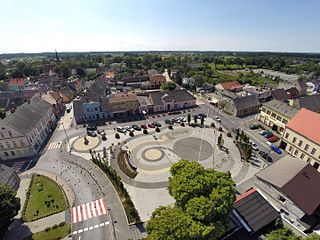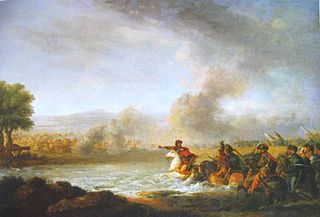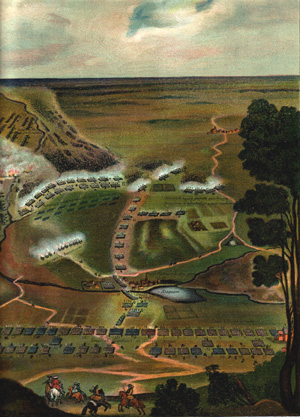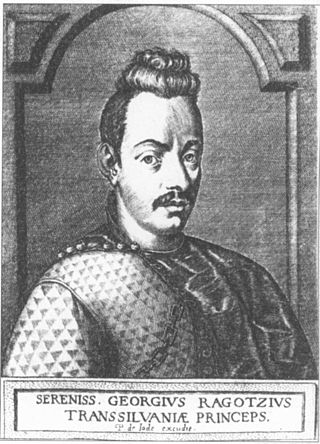
Charles X Gustav, also Carl X Gustav, was King of Sweden from 1654 until his death. He was the son of John Casimir, Count Palatine of Zweibrücken-Kleeburg and Catherine of Sweden. After his father's death he also succeeded him as Pfalzgraf. He was married to Hedwig Eleonora of Holstein-Gottorp, who bore his son and successor, Charles XI. Charles X Gustav was the second Wittelsbach king of Sweden after the childless king Christopher of Bavaria (1441–1448) and he was the first king of the Swedish Caroline era, which had its peak during the end of the reign of his son, Charles XI. He led Sweden during the Second Northern War, enlarging the Swedish Empire. By his predecessor Christina, he was considered de facto Duke of Eyland (Öland), before ascending to the Swedish throne. From 1655 to 1657, he was also Grand Duke of Lithuania.

The Deluge was a series of mid-17th-century military campaigns in the Polish–Lithuanian Commonwealth. In a wider sense, it applies to the period between the Khmelnytsky Uprising of 1648 and the Truce of Andrusovo in 1667, comprising the Polish theatres of the Russo-Polish and Second Northern Wars. In a stricter sense, the term refers to the Swedish invasion and occupation of the Commonwealth as a theatre of the Second Northern War (1655–1660) only; in Poland and Lithuania this period is called the Swedish Deluge, or less commonly the Russo–Swedish Deluge due to the simultaneous Russo-Polish War. The term "deluge" was popularized by Henryk Sienkiewicz in his novel The Deluge (1886).

The Northern War of 1655–1660, also known as the Second Northern War, First Northern War or Little Northern War, was fought between Sweden and its adversaries the Polish–Lithuanian Commonwealth (1655–60), the Tsardom of Russia (1656–58), Brandenburg-Prussia (1657–60), the Habsburg monarchy (1657–60) and Denmark–Norway. The Dutch Republic waged an informal trade war against Sweden and seized the colony of New Sweden in 1655, but was not a recognized part of the Polish–Danish alliance.

Inowrocław is a city in central Poland with a total population of 68,101. It is situated in the Kuyavian-Pomeranian Voivodeship. It is one of the largest and most historically significant cities within the historic region of Kuyavia.

The Battle of Warsaw took place near Warsaw on July 28–July 30 [O.S. July 18–20] 1656, between the armies of the Polish–Lithuanian Commonwealth and Sweden and Brandenburg. It was a major battle in the Second Northern War between Poland and Sweden in the period 1655–1660, also known as The Deluge. According to Hajo Holborn, it marked "the beginning of Prussian military history".

The siege of Warsaw took place between April 24 and July 1, 1656. Swedish Empire forces had occupied the Polish capital without fighting in early September 1655. In late April 1656, Poles and Lithuanians began the siege, with the purpose of recapturing their capital. They were successful, but later lost the city for a second time after a battle held on July 28–30, 1656.

Szubin is a town in Nakło County, Kuyavian-Pomeranian Voivodeship, Poland, located southwest of Bydgoszcz. It has a population of around 9,333. It is located on the Gąsawka River in the ethnocultural region of Pałuki.

The Battle of Warka occurred on April 7, 1656 between the forces of the Polish–Lithuanian Commonwealth, commanded by Stefan Czarniecki, and the forces of the Swedish Empire, commanded by Frederick VI, Margrave of Baden-Durlach. Lasting about two hours, the battle ended in a Polish victory.

The Battle of Ujście was fought on July 24–25, 1655 between forces of the Polish–Lithuanian Commonwealth commanded by Krzysztof Opaliński and Andrzej Grudziński on one side, and on the other Swedish forces commanded by Arvid Wittenberg. Krzysztof Opaliński and Bogusław Leszczyński, dissatisfied with policies of King John II Casimir of Poland, decided to become Swedish allies together with the pospolite ruszenie of Greater Poland to Charles X Gustav of Sweden.

The Battle of Kłecko was fought on May 7, 1656, between forces of the Polish–Lithuanian Commonwealth commanded by Regimentarz Stefan Czarniecki and Jerzy Sebastian Lubomirski and a Swedish force commanded by prince Adolf Johan av Pfalz-Zweibrücken. The Polish–Lithuanian force was more than 12,000 strong and consisted mostly of cavalry, while the Swedes numbered around 7,000 artillery, infantry and cavalry. The Swedes achieved a tactical victory in that they escaped destruction by the Poles, who were unable to get to the Swedish army entrenched behind the Welnianka River, and various ditches and swamps. Swedish army lost 428 dead, while the Polish army sustained 70 dead and wounded, 2,000 dead or 3,000 dead, including 40 companions dead.

The Battle of Żarnów was fought on September 16, 1655, between the forces of the Polish–Lithuanian Commonwealth, commanded by John II Casimir and the forces of the Swedish Empire, commanded by Charles X Gustav. The result ended with a Swedish victory.

The Battle of Gołąb was fought on either 18 or 19 February 1656, between forces of the Polish–Lithuanian Commonwealth commanded by Stefan Czarniecki on one side, and on the other Swedish Empire's army commanded by Charles X Gustav. This battle was essentially a meeting engagement with Swedish troops arriving on the battlefield at different times. It is uncertain how many actually participated, and its actual date is disputed. Some sources, such as Polish-language Military Encyclopedia, claim it took place on 18 February, while historian Leszek Podhorecki wrote that it was on 19 February.

The Battle of Chojnice, also known as the Battle of Konitz, was a surprise nighttime attack followed by a run-and-chase battle during The Deluge.

The siege of Kraków was one of the battles during the Swedish invasion of Polish–Lithuanian Commonwealth. Lasting for two and a half weeks, it started on September 25 and ended on October 13, 1655. The capitulation treaty was signed on October 17, and Polish troops marched out of the city two days later. The city's defense was led by Kiev's castellan Stefan Czarniecki, while Swedish forces were commanded by King Charles Gustav and Arvid Wittenberg.
The Battle of Jarosław took place during the Deluge on March 15, 1656. Polish-Lithuanian Commonwealth forces under the command of Stefan Czarniecki defeated the Swedish forces commanded by Charles X Gustav of Sweden.

The siege of Toruń was one of the battles during the Swedish invasion of Polish–Lithuanian Commonwealth. It started on 2 July 1658 and ended on 30 December 1658. Swedish garrison capitulated and Toruń returned to Polish hands.
The Battle of Tykocin took place on 13 July 1656 and was one of battle of the Swedish invasion of Poland. It resulted in a victory of Sweden and Brandenburg forces, commanded by Duke Boguslaw Radziwill, and ended siege of Tykocin.
The Battle of Nisko was one of battles of the Swedish invasion of Poland that took place on March 28, 1656. It resulted in a victory of Swedish forces, commanded by King Charles X Gustav.

The Battle of Magierów took place on 11 July 1657, during Polish history known as the Swedish Deluge. Polish army commanded by Stefan Czarniecki, and supported by Crimean Tatars, defeated a Transilvanian-Cossack-Moldavian-Wallachian army of George II Rákóczi.

The Battle of Czarny Ostrów took place on July 20, 1657, during the period in Polish history known as the Deluge. The Polish Crown army commanded by Hetmans Stefan Czarniecki, Jerzy Lubomirski and Stanisław Potocki, supported by Crimean Tatars, defeated a Transylvanian-Cossack-Moldavian-Wallachian army under George II Rakoczi.
















